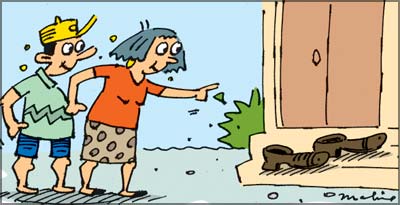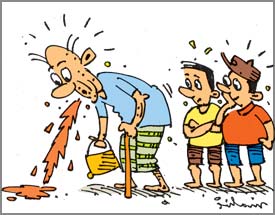|

by R. S. Karunaratne
Parts
of speech
Classification of
pronouns
A pronoun is a word used as a substitute for another noun. It is used
to avoid the repetition of a noun in a sentence or a passage.Pronouns
are classified into several groups:
1. Personal pronouns
Personal pronouns stand for the three persons as follows:
(a) First person (The person speaking)
I am a student. (Singular)
|

These are his shoes. |
We are students. (Plural)
(b). Second person (The person spoken to)
You are the principal. (Singular)
You are pupils. (Plural)
(c). Third person (The person spoken of)
He is a bright student. (Singular)
She is a good artist. (Singular)
It wags its tail. (Singular)
They are my friends. (Plural)
When a pronoun stands for a collective noun, considered as a whole,
it is followed by a singular verb.
The army is advancing, killing the terrorists.
The fleet of buses is ready for shipment.
The jury will give its verdict tomorrow.
When a collective noun gives the idea of separate individuals it is
followed by a plural verb.
The jury are divided in their opinion.
The committee decided to give their different opinions.
2. Demonstrative
pronouns
Demonstrative pronouns point out the objects to which they refer.
This camera is mine.
These are his shoes.
That car belongs to my father.
Those houses were built by the government.
'That' and `those' are used to avoid the repetition of a particular
noun already mentioned.
The climate of England is like that of France.
The street cleaners of Panadura are worse than those of Colombo.
3. Indefinite
pronouns
Indefinite pronouns refer to persons or things in a general way.
One should not spit in public places.
One must not make unfair profit.
|

One should not spit in
public places. |
None of his books are available in bookshops.
They say the government will win the PC election. (people in general)
Somebody has stolen my car.
Nobody wants to remain poor.
Anybody can do this job.
Everybody is happy to work here.
4. Distributive
pronouns
Distributive pronouns refer to persons or things one at a time. These
pronouns are singular and are followed by singular verbs.
Each of the girls received an exercise book.
Either of the roads leads to school.
5. Interrogative
pronouns
Interrogative pronouns are used to ask questions.
Who is this man?
Which class is clean?
What is the time?
They can be used to ask indirect questions.
I want to know who you are.
Ask what he wants now.
Tell me which colour you prefer.
6. Reflexive pronouns
Reflexive pronouns are formed by adding '-self' to 'my, your, him,
her' and 'it.' The plural is formed by adding '-selves' to 'our, your,
them.'
I cut myself.
Don't hurt yourself.
The boys hurt themselves.
7. Emphatic pronouns
Compound personal pronouns are used for emphasis.
I did it myself.
We will see to it ourselves.
You yourself can do it.
They themselves pleaded guilty.
The house itself is not very big.
'Colour' idioms
|
Those who
study English as a second language face many problems.
Perhaps, idioms pose the biggest problem.
Here is a carefully selected list of idioms connected with
the word ‘colour.’ For the sake of convenience, let’s call
them ‘colour idioms.’ Tick off the meaning you think is
correct.
1. When I saw my friend scolding a beggar, I saw him in his
true colours.
(a) I understood his real character
(b) I saw him getting angry
(c) I realised his kindness.
2. His bruised hands and torn clothes lent colour to his
claim that he had been assaulted by someone.
(a) made it incredible
(b) made it credible
(c) made it serious
3. My brother passed GCE A/L exam with flying colours.
(a) with great difficulty
(b) with low marks
(c) with distinction
4. Being a spy Edward always sailed under false colours.
(a) travelled alone
(b) assumed a false identity
(c) sailed in an enemy ship
To be continued
Solution: 1 (a), 2
(b), 3 (c), 4 (b) |
|

